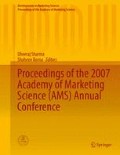Abstract
The paper contributes to online marketing performance measurement and brand equity body-of-research knowledge by developing and validating a new metric of brand equity that takes into account the special characteristics of the Web which render consumers co-creators of brand value. Various tests provided evidence of the scale’s sound psychometric properties.
Access this chapter
Tax calculation will be finalised at checkout
Purchases are for personal use only
Preview
Unable to display preview. Download preview PDF.
References
Aaker, D. A. 1991. Managing Brand Equity. NY: Free Press.
Ambler, T. 2003. Marketing and the Bottom Line. 2nd Edition. London: FT.
Armstrong, S. J. and T. S. Overton. 1977. “Estimating Nonresponse Bias in Mail Surveys.” Journal of Marketing Research 14 (3): 396–402.
Brown, S., R. V. Kozinets and J. F. Sherry. 2003. “Teaching Old Brands New Tricks: Retro Branding and the Revival of Brand Meaning.” Journal of Marketing 67 (July): 19–33.
Bruner, G. C, K. E. James, and P. J. Hensel. 2001. Marketing Scale Handbook. Chicago: American Marketing Association.
Carmines, E. G. and J. P. Mclver. 1981. “Unobserved Variables”. In: Social Measurement: Current Issues, (eds.) G.W. Bohrnstedt and E.F. Borgatta. CA: Sage.
Christodoulides, G., L. de Chernatony, O. Furrer, and T. Abimbola. 2006. “Conceptualising and Measuring the Equity of Online Brands.” Journal of Marketing Management 22 (7/8): 799”825.
Churchill, G. A. 1979. “A Paradigm for Developing Better Measures of Marketing Constructs.” Journal of Marketing Research 26 (Feb): 64–73.
de Chernatony, L. and G. Christodoulides. 2004. “Taking the Brand Promise Online: Challenges and Opportunities.” Interactive Marketing 5 (3): 238–251.
Erdem, T. and J. Swait. 1998. “Brand Equity as a Signaling Phenomenon.” Journal of Consumer Psychology 7 (2): 131–157.
Erdem, T., J. Swait, and A. Valenzuela. 2006. “Brands as Signals: A Cross Country Validation Study.” Journal of Marketing 70 (Jan.): 34–49.
Fornell, C. and D. F. Larcker. 1981. “Evaluating Structural Equation Models with Unobserved Variables and Measurement Error.” Journal of Marketing Research 18 (1): 39–50.
Gerbing, D. W. and J. C. Anderson. 1988. “An Updated Paradigm for Scale Development Incorporating Unidimensionality and its Assessment.” Journal of Marketing Research 25 (2): 186–192.
Graeff, T. R 1997. “Consumption Situations and the Effects of Brand Image on Consumers’ Brand Evaluations.” Psychology & Marketing 14 (1): 49–70.
Hair, J. F., R. E. Anderson, R. L. Tatham, and W. C. Black. 1998. Multivariate Data Analysis. 5th Edition, NJ: Prentice-Hall.
Hoeffler, S., & Keller, K. L. 2003. “The Marketing Advantages of Strong Brands.” Journal of Brand Management 10 (6): 421–45.
Hoffman, D. L. and T. P. Novak. 1996. “Marketing in Hypermedia Computer-Mediated Environments.” Journal of Marketing 60 (3): 50–68.
Holt, D. B. 2002. “Why Do Brands Cause Trouble? A Dialectical Theory of Consumer Culture and Branding.” Journal of Consumer Research 29 (1): 70–90.
Hu, L-T and P. M. Bentler. 1999. “Cutoff Criteria for Fit Indices in Covariance Structure Analysis.” Structural Equation Modeling 6(1): 1–55.
Keller, K. L. 1993. “Conceptualizing, Measuring and Managing Customer-Based Brand Equity.” Journal of Marketing 57 (1): 1–22.
Kim, J., S. Sharma, and K. Setzekorn. 2002. “A Framework for Building Brand Equity Online for Pure-Play B2C Retailers and Services.” International Journal of Media Management 4 (2): 123–133.
Loiacono, E. T., R. T. Watson, and D. L. Goodhue. 2002. “WebQual: A Measure of Website Quality.” Winter Marketing Educators’ Conference Austin. 432–438.
Nunnally, J. C. 1978. Psychometric Theory. NY: McGraw-Hill.
Page, C. and E. Lepkowska-White. 2002. “Web Equity: A Framework for Building Consumer Value in Online Companies.” Journal of Consumer Marketing 19 (2/3): 231–248.
Paterson, R. A., S. Balasubramanian, and B. Bronnenberg. 1997. “Exploring the Implications of the Internet for Consumer Marketing.” Journal of the Academy of Marketing Science 25 (4): 329–346.
Pavlou, P. A. and D. W. Stewart. 2000. “Measuring the Effects and Effectiveness of Interactive Advertising: A Research Agenda.” Journal of Interactive Advertising 1 (1) Available at http://jiad.org/voll/nol/pavlou/index.html.
Ping, R. A. 2004. “On Assuring Valid Measures for Theoretical Models Using Survey Data.” Journal of Business Research 57 (2): 125–141.
Rust, R. T., V. A. Zeithaml, and K. N. Lemon. 2004. “Customer-Centered Brand Management.” Harvard Business Review 82(9): 110–118.
Vargo, S. L. and R. F. Lusch. 2004. “Evolving to a New Dominant Logic for Marketing.” Journal of Marketing 68 (1): 1–17.
Yoo, B. and N. Donthu. 2001. “Developing and Validating a Multidimensional Consumer-Based Brand Equity Scale.” Journal of Business Research 52 (1): 1–14.
Author information
Authors and Affiliations
Editor information
Editors and Affiliations
Rights and permissions
Copyright information
© 2015 Academy of Marketing Science
About this paper
Cite this paper
Christodoulides, G., de Chernatony, L., Furrer, O. (2015). Moving Away From Short-Term Performance Measurement Online: A New Metric of Brand Equity. In: Sharma, D., Borna, S. (eds) Proceedings of the 2007 Academy of Marketing Science (AMS) Annual Conference. Developments in Marketing Science: Proceedings of the Academy of Marketing Science. Springer, Cham. https://doi.org/10.1007/978-3-319-11806-2_125
Download citation
DOI: https://doi.org/10.1007/978-3-319-11806-2_125
Published:
Publisher Name: Springer, Cham
Print ISBN: 978-3-319-11805-5
Online ISBN: 978-3-319-11806-2
eBook Packages: Business and EconomicsBusiness and Management (R0)

